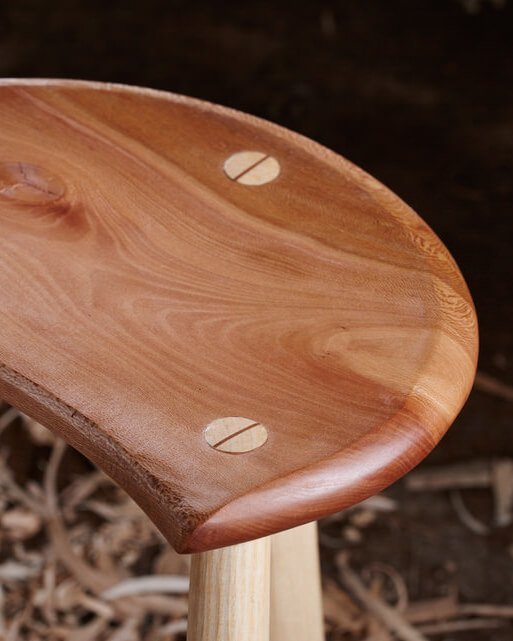Working with Greenwood by Peter Lanyon
I (Peter Lanyon) am very lucky to have a big and beautiful workshop a stone's throw from the sea in an old converted cow shed. I grew up on the outskirts of Plymouth, and Mothecombe beach near the workshop is where we used to go as a family.
I got my mid-life crisis out of the way early, deciding to throw in my rather haphazard career and train as a furniture maker at Rycotewood College, which was at the time considered one of the top places to learn fine furniture making in the country. I have always loved making things, but Rycotewood made incredible demands on us all to be flawless in our execution. My interest in design came later after I had learned to make, and I went on to gain an MA with distinction from High Wycombe College.
I took on my workshop, the Devon Green Wood Centre, around one year ago. It has a secluded, spacious feel and is ideal for making the work and for welcoming people on courses. It is a short walk from the coast path with breathtaking views, so lunch times are often spent enjoying all that is best in Devon. The center offers something of the seclusion and peace of working in woodland but with the advantages that powered tools and machines offer.
I am always looking for new suppliers of good quality, local coppice wood – in particular ash, cherry, and my particular favorite, sweet chestnut. In addition to buying air-dried boards and some coppice woods from small woodland owners, we sometimes mill our own wood, often from trees donated by a landowner who would like to see it put to good use.
What is green wood?
Green wood simply means unseasoned. We usually work with young trees of around 30 years old, or 6” - 9” diameter. Oak is the exception – it needs to be at least 18” in diameter before there is any significant amount of heartwood, the sapwood being very susceptible to boring insects. The advantages of green wood are that it can be cleaved and shaved instead of being put through a saw. I feel that straight edges and right angles are over-rated; trees grow in beautiful, undulating, organic shapes that tell their history, so why cut them into flat, straight, lifeless edges and surfaces? The process of converting trees into furniture components needn't be noisy or dusty – it can be physically and emotionally satisfying and be carried out virtually anywhere. Wood that is cleaved is inherently stronger than sawn wood, meaning components can be made lighter.
The furniture
The starting point for my work is always the material. Some chestnut poles with a gentle reciprocating curve call out to be shaved into lamps, other times I will start with one idea, say a chair leg, and find at the end of the day I have made spindles, or it has even become a table lamp. The wood tells you what it wants to be. That is one of the joys of green woodworking – you never impose a design on green wood; it tells you how it’s going to be based on how it cleaves and works. Along with a range of cleft-wood lamps and furniture, I explore the possibilities of steam-bending, which can be done most successfully while the timber is still green. The real challenge and love is in working out how to make a new piece, using bits of wood that are not straight and are going to shrink is a very interesting design constraint to work within, which demands all kinds of ingenuity. Having said that, I still look forward with immense satisfaction to a day spent on the shave horse, shaping standard lamps”. These days I work a lot to commission. The commissioning process is an interesting one, working with such unpredictability means it is impossible to present someone with a finished drawing of what their piece will look like. We overcome that through close dialogue and using photography to keep people informed about what we are proposing, and a relationship of trust develops.
Community woodworking
I have been involved in quite a number of community projects, often for benches for a community orchard or seating or a table for a school. I give demonstrations at local fairs, where people are invited to have a go at making a spatula or a butter knife. This is often enough to get people hooked, and getting volunteers for a project is never difficult; cleaving and shaving wood is such a pleasurable and enjoyable experience. I usually start with a construction idea, one that lends itself to a number of people making individual components. These are then usually seasoned for a while, before the group comes together again to assemble them into the final piece. I use a lot of jigs and work aids to assist people who may not have previous experience, to ensure that joints are tight and accurate, and one of the wonderful things about green woodworking is that everybody can achieve good results very quickly.
Working sustainably
My work is pretty much unique – my approach is not one of nostalgia for a past way of doing things but in re-imagining how this wonderful material and technique can be made even more relevant in today's world. It always amuses me that the bodgers of the past were operating out of the same needs as we have now, using local, sustainable, and renewable resources, reducing energy consumption and transportation costs. These are all incredibly important factors in how we produce artifacts today. It seems to me that no piece of furniture can really be called “contemporary” if it doesn't address these very real issues. We've just taken a long time to remember that it makes sense to work in this way, and we need people who will manage our woodlands now, for the benefit of future generations.
- written by Peter Lanyon
Join us for our Green Woodworking Course.
An immersive journey guided by Peter Lanyon at Cerdeira - Home for Creativity.











